
Microhyla sholigari is a species of microhylid frog endemic to southern India. It was described from the Biligirirangan Hills in Chamarajanagar district, Karnataka and is named after the Soliga tribal people living in the forests in and around these hills. The frog was thought to be endemic to the Western Ghats and known only from the type locality and another location in Kerala and was listed as an Endangered species. A recent study reported the species from 15 localities in the central Western Ghats with individuals sighted near the Bannerghatta National Park, Bangalore, Karnataka. The study supplemented the original species description with color photographs, call recordings and provided a re-assessment of the threat status as per the IUCN Red List and suggest the status as Least-concern species because the criteria for classifying it as an endangered species are no longer fulfilled.
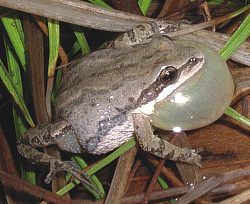
The western chorus frog, also known as striped chorus frog, or midland chorus frog is a species of frog found in Canada and the United States.

Microhyla ornata, commonly known as the ornate narrow-mouthed frog, ornate narrow-mouthed toad, or ornamented pygmy frog, is a species of microhylid frog found in South Asia. This amphibian is distributed in Kashmir, Nepal, peninsular India and the Andaman and Nicobar Islands, Sri Lanka, and Bangladesh. It was previously considered to be the same species as Microhyla fissipes; therefore, the aforementioned common names can refer to either species.

Kaloula baleata, the flower pot toad or sometimes the smooth-fingered narrow-mouthed frog, is a species of narrow-mouthed toad. It is native to India, Borneo, Indochinese Peninsula, Java, Malay Peninsula and Philippines where it lives in lowland rainforests and is tolerant of disturbed sites. The IUCN lists it as being of "Least Concern".

Microhyla berdmorei is a species of narrow-mouthed frog found in eastern India, Bangladesh, southernmost China (Yunnan), Mainland Southeast Asia as well as Borneo and Sumatra. Frogs from Bangladesh probably represent an unnamed species.
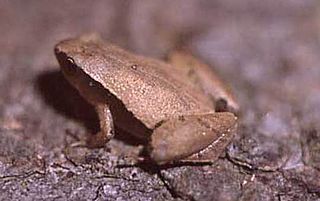
Microhyla heymonsi, also known as the dark-sided chorus frog or the Taiwan rice frog, is a species of narrow-mouthed frog found in northeastern India, southern China, Taiwan, and Southeast Asia south to the Malay Peninsula and Sumatra as well as the Great Nicobar Island. It was originally described from Taiwan.

Microhyla achatina, commonly known as the Javan chorus frog, Java rice frog, or Javanese narrow-mouthed frog, is a species of narrow-mouthed frog endemic to Java, Indonesia.

Xenophrys longipes is a species of frog in the family Megophryidae. It is also known as the Malacca spadefoot toad, red legged spine-eyed frog, red-legged horn frog, and slender-legged horned frog. It is found in the Malay Peninsula. Records from Cambodia and Vietnam are considered doubtful.

Glyphoglossus brooksii is a species of frog in the family Microhylidae. It is endemic to Borneo and found in Kalimantan (Indonesia) and Sarawak (Malaysia). Its common names are Brooks' squat frog and Brooks' burrowing frog. It is named after Mr. Cecil J. Brooks who collected the holotype "in a hole whilst prospecting" in Bidi, Sarawak.
Glyphoglossus smithi, also known as Smith's squat frog or Smith's burrowing frog, is a species of frog in the family Microhylidae. It is endemic to Sabah and Sarawak in Malaysian Borneo. However, it is likely to occur more widely than currently known and be present in Brunei and Indonesia. The specific name smithi honours Dr Harrison Willard Smith, an American scientist who collected the holotype from the Limbang River district.
Microhyla borneensis, also known as the Matang narrow-mouthed frog, is a species of microhylid frog found in the Matang Range in Sarawak, Borneo. It was once the smallest known frog from the Old World. Adult males of this species have a snout-vent length (SVL) of 10.6–12.8 mm (0.42–0.50 in), but adult males can reach a maximum of 13 mm (0.51 in),and adult females of this species have a snout-vent length of 16–19 mm (0.63–0.75 in), Tadpoles measure just 3 mm.

The painted chorus frog, also commonly known as Butler's narrow-mouthed toad, Butler's pigmy frog, Butler's rice frog, Butler's ricefrog, noisy frog or tubercled pygmy frog, is a species of frog in the family Microhylidae. It is found in northeast India, Myanmar, southern China, Hong Kong, Taiwan, Thailand, Cambodia, Laos, Vietnam, Peninsular Malaysia, and Singapore. Its natural habitats are subtropical or tropical moist lowland forest, subtropical or tropical moist montane forest, subtropical or tropical moist shrubland, swamps, intermittent freshwater marshes, arable land, plantations, rural gardens, ponds, open excavations, and irrigated land. It is not considered threatened by the IUCN.
Microhyla karunaratnei is a species of frog in the family Microhylidae. It is endemic to southern Sri Lanka. It is also known as the Karunaratne's narrow-mouth frog or Karunaratne's narrow-mouthed frog. The specific name karunaratnei honours G. Punchi Banda Karunaratne, a Sri Lankan naturalist.
Microhyla maculifera is a species of frog in the family Microhylidae. It is endemic to Borneo, specifically to the Danum Valley Conservation Area in Sabah, Malaysia. It inhabits leaf litter on the forest floor and presumably breeds in small rain pools. Its habitat is well protected in the Danum Valley Conservation Area, but its small range makes it vulnerable to chance events.
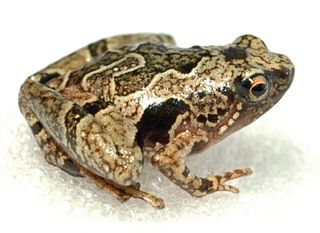
Nanohyla petrigena is a species of frog in the family Microhylidae. It is found in northern and central Borneo and in the Sulu Archipelago of the Philippines. The common names pothole narrow-mouthed frog and Kapit rice frog have been coined for the species.

Leptomantis angulirostris, commonly known as the masked tree frog, is a member of the tree frog family Rhacophoridae and is found in Indonesia and Malaysian Borneo. Its natural habitats are subtropical or tropical moist lowland forests, subtropical or tropical moist montane forests, and rivers. It is threatened by habitat loss.

Microhyla fissipes is a microhylid frog from East and Southeast Asia, from southern and central China and Taiwan to the Malay Peninsula. It was previously considered to be the same species as Microhyla ornata of South Asia; thus the common names ornate narrow-mouthed frog or ornamented pygmy frog can refer to either species.
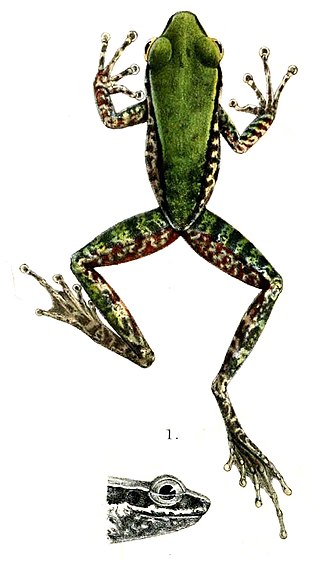
Chalcorana macrops is a species of "true frog" in the family Ranidae. It is endemic to Sulawesi, Indonesia. Common name Masarang frog has been coined for it. The specific name macrops refers to the large eyes of this frog.
The chorus frog (Pseudacris) is a genus of frogs in the family Hylidae found in North America ranging from the Pacific coastline to the Atlantic.
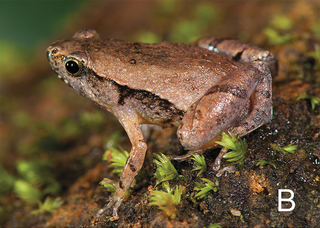
Microhyla darreli is a species of frog in the family Microhylidae, the narrow-mouthed frogs. It is endemic to the Western Ghats south of the Palghat Gap in southern India. It is named for Darrel Frost, an American herpetologist, in recognition of the online database Amphibian Species of the World that he maintains. Accordingly, common name Darrel's chorus frog has been coined for this species.
















